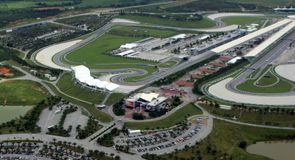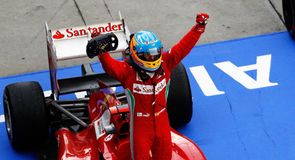 History
History
The
circuit was designed by German designer Hermann Tilke, who would
subsequently design the new facilities in Shanghai, Bahrain, Turkey,
Valencia, Singapore, Abu Dhabi, Korea, India and Austin, TX.The circuit was officially inaugurated by the 4th Prime Minister of Malaysia's Tun Doktor Mahathir Bin Mohamad on 7 March 1999 at 20:30 MST (UTC+08:00). He subsequently went on to inaugurate the first Moto GP Malaysian Grand Prix on 20 April 1999 (see 1999 Malaysian motorcycle Grand Prix) and the first Formula One Petronas Malaysian Grand Prix on 17 October 1999 (see 1999 Malaysian Grand Prix).
On October 23, 2011, on the second lap of the 2011 Malaysian motorcycle Grand Prix, the Italian motorcycle racer Marco Simoncelli died following a crash in turn 11. The race was cancelled following the accident.
 Layout
Layout
The main circuit, normally raced in a clockwise direction, is 5.543
kilometres long, and is noted for its sweeping corners and wide
straights. The layout is quite unusual, with a very long back straight
separated from the pit straight by just one very tight hairpin.The south circuit is the other half of the racecourse. The back straight of the main circuit becomes the pit straight when the south circuit is in use, and joins onto turn 8 of the main circuit to form a hairpin turn. Also run clockwise, this circuit is 2.61 km in length.
Sepang International Circuit also features kart racing and motocross facilities.
A lap in a Formula One car
 Sepang
starts with a long pit straight where the DRS zone exists - it is
important to get a good exit out of the last corner to gain as much
speed as possible. Turn 1 is a very long, slow corner taken in second
gear. You brake incredibly late and lose speed gradually as you file
round the corner, similar to Shanghai's first turn but slower. Turn 1
leads straight into Turn 2, a tight left hairpin which goes downhill
quite significantly. The first two corners are quite bumpy, making it
hard to put power onto the track. Turn 3 is a long flat out right hander
which leads into Turn 4 - known locally as the Langkawi Curve - a
second gear, right-angle right-hander. Turns 5 and 6 make up an
incredibly high-speed, long chicane that hurts tyres and puts a lot of
stress on drivers due to high G-Force. It is locally known as the
Genting Curve. Turns 7 and 8 (the KLIA curve) make up a long,
medium-speed, double-apex right hander, and a bump can cause the car to
lose balance here. Turn 9 is a very slow left-hand hairpin (the Berjaya
Tioman Corner), similar to turn two but uphill. Turn 10 leads into a
challenging, medium-speed right hander at turn 11, requiring braking and
turning simultaneously. Turn 12 is a flat-out, bumpy left which
immediately leads into the flat right at turn 13, then the challenging
'Sunway Lagoon' curve at turn 14. Similar to turn 11, it requires
hard-braking and steering at the same time. It is taken in second gear.
The long back straight can be a good place for overtaking as you can
brake hard into turn 15, a left-handed, second-geared hairpin but you
have to be careful not to get re-overtaken as you come into turn 1
again.
Sepang
starts with a long pit straight where the DRS zone exists - it is
important to get a good exit out of the last corner to gain as much
speed as possible. Turn 1 is a very long, slow corner taken in second
gear. You brake incredibly late and lose speed gradually as you file
round the corner, similar to Shanghai's first turn but slower. Turn 1
leads straight into Turn 2, a tight left hairpin which goes downhill
quite significantly. The first two corners are quite bumpy, making it
hard to put power onto the track. Turn 3 is a long flat out right hander
which leads into Turn 4 - known locally as the Langkawi Curve - a
second gear, right-angle right-hander. Turns 5 and 6 make up an
incredibly high-speed, long chicane that hurts tyres and puts a lot of
stress on drivers due to high G-Force. It is locally known as the
Genting Curve. Turns 7 and 8 (the KLIA curve) make up a long,
medium-speed, double-apex right hander, and a bump can cause the car to
lose balance here. Turn 9 is a very slow left-hand hairpin (the Berjaya
Tioman Corner), similar to turn two but uphill. Turn 10 leads into a
challenging, medium-speed right hander at turn 11, requiring braking and
turning simultaneously. Turn 12 is a flat-out, bumpy left which
immediately leads into the flat right at turn 13, then the challenging
'Sunway Lagoon' curve at turn 14. Similar to turn 11, it requires
hard-braking and steering at the same time. It is taken in second gear.
The long back straight can be a good place for overtaking as you can
brake hard into turn 15, a left-handed, second-geared hairpin but you
have to be careful not to get re-overtaken as you come into turn 1
again.
Fastest laps timed

No comments:
Post a Comment